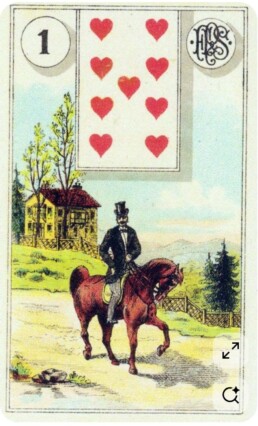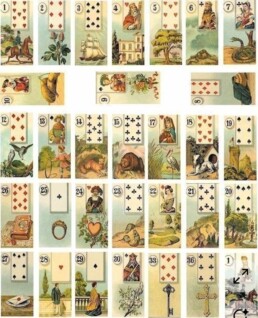Understanding the Lenormand Cards
The Lenormand cards are one of the most intriguing and practical tools in the world of divination. Unlike the more widely known tarot, Lenormand readings are direct, structured, and focused on real-world events. Each card offers clear symbolism that reflects everyday life — love, work, family, opportunities, and challenges — and when combined, these images form a story that gives insight into the querent’s situation.
Named after Marie Anne Adelaide Lenormand (1772–1843), a famous French fortune-teller and advisor to figures like Napoleon Bonaparte and Empress Josephine, the Lenormand oracle draws its inspiration from the decks used in her time. After her death, card makers created a deck in her honour, blending symbolic playing cards with everyday imagery — the result became the Petit Lenormand, a 36-card oracle deck that is so popular today.
Where tarot leans into archetypes and psychology, Lenormand focuses on events, details, and timing. A Lenormand reading doesn’t usually speak in metaphor; it delivers facts. The deck works like a language — each card acts as a word, and the reader’s job is to string those words into meaningful sentences.

The Structure of the Lenormand Deck
The Petit Lenormand deck consists of 36 cards, each bearing a simple image and a corresponding playing card inset. The imagery includes familiar symbols — a Heart, Ring, Tree, Coffin, Book, Ship, and more. These images are not mystical abstractions but reflections of real-life concepts.
Here’s a brief glimpse into a few of the key cards:

- The Rider (1): News, movement, or new developments. Something is arriving soon.
- The Clover (2): Luck, opportunities, small chances that can grow if acted upon.
- The Ship (3): Travel, expansion, or ventures beyond one’s comfort zone.
- The House (4): Home, family, stability, or private matters.
- The Tree (5): Health, longevity, or deep-rooted connections.
- The Clouds (6): Confusion, uncertainty, unclear situations.
- The Snake (7): Complications, deception, or challenges through a cunning person.
- The Coffin (8): Endings, transformation, release, or closure.
- The Ring (25): Commitments, contracts, relationships, or cycles.
- The Heart (24): Love, affection, joy, and emotional fulfillment.
Each card on its own offers a simple meaning. But the power of Lenormand lies in combination. For example:
- Heart + Ring could mean a loving relationship or romantic commitment.
- Coffin + Ring might indicate a breakup or ending of an agreement.
- Ship + Clover could suggest a lucky trip or an unexpected opportunity abroad.
Because of this, Lenormand is often described as a system of syntax — the cards form sentences that create a narrative about your question or situation.
How Lenormand Differs from Tarot
While both tarot and Lenormand are forms of cartomancy, their approach and philosophy differ significantly:
- Tarot is symbolic, spiritual, and psychological. It often explores inner growth, archetypes, and subconscious themes.
- Lenormand is practical, descriptive, and predictive. It answers “what,” “when,” and “how” more than “why.”
For example, if you asked both decks the same question — “Will I get the job?” — tarot might discuss your self-worth, confidence, or the lessons of this opportunity. Lenormand, however, would show whether the offer will come, who might influence it, and when to expect movement.
Because of this, Lenormand readings can feel startlingly accurate, sometimes even mundane — yet their value lies in their precision. The cards cut through confusion to reveal tangible insight about events and people.
What to expect from a Lenormand reading
A Lenormand reading feels like a conversation with destiny – part logic, part intuition, and all symbolism. When you sit down for a reading, the process typically unfolds in a few key steps:
1. Setting the Intention
The reader will begin by helping you formulate a clear question. Lenormand thrives on specificity. Questions like “What’s coming next in my love life this month?” or “How will my finances develop by year’s end?” work far better than open-ended spiritual inquiries.
The clearer your focus, the sharper the reading’s accuracy.
2. Choosing a Spread
Lenormand offers several reading layouts, each with its own depth:
- Single Card Draw: A simple, daily guidance pull — quick and direct.
- 3-Card Spread: Tells a short story — past, present, and near future.
- 9-Card Spread (Box Spread): Offers a deeper look into current influences and outcomes.
- Grand Tableau: The signature Lenormand spread using all 36 cards, mapping out every area of life over months or even a year.
The Grand Tableau is especially famous. It spreads all cards in a grid, where each card’s position relative to the Significator (your personal card, usually the Man or Woman) reveals insight into love, work, home, and destiny. It is a panoramic view of your life’s currents.
3. Reading the Combinations
The reader interprets cards in pairs or strings. Each pair modifies or clarifies the other, revealing a sentence-like message.
For instance:
- Book + Key = Important knowledge revealed or an answer discovered.
- Fox + Fish = Caution in business or tricky money matters.
- Sun + Star = Success, clarity, and renewed optimism.
A skilled reader weaves these combinations into a cohesive story – one that highlights where energy flows and what outcomes to expect.
4. Timing and Prediction
Lenormand excels at timing, often identifying the “when” of events through positional patterns, card numbers, or suits. While timing isn’t always exact, the reading often reveals phases — soon, delayed, or long-term developments.
5. Practical Guidance
Expect grounded, actionable advice. A Lenormand reading won’t float in mysticism — it provides clarity, direction, and options. You may walk away with a clearer understanding of people’s motives, the next opportunity, or how to navigate a challenge.

The Experience and Energy
A Lenormand reading feels anchored in reality yet touched by fate. It can confirm what your intuition already knows, or it may uncover hidden dynamics — an unseen ally, a delayed opportunity, or a subtle warning.
Many clients describe the experience as empowering rather than mystical. Because the cards reflect tangible energy, the reading often validates your instincts and offers confidence to act decisively.
The best readers approach Lenormand with a blend of intuition and structure – they respect the tradition of the system while allowing the cards to speak naturally.
Developing Your Relationship with the Cards
Learning Lenormand is like learning a new language — once you understand the “grammar” of combinations, the messages flow effortlessly. Daily practice with two- or three-card draws can build familiarity. Over time, you’ll notice the cards begin to “speak” more fluidly, offering insight not only in readings but in daily life decisions.
Many readers describe their deck as a trusted friend — honest, sometimes blunt, but always clear. Unlike tarot, Lenormand doesn’t sugarcoat. It tells it as it is, helping you see life’s moving pieces from a strategic, empowered perspective.
Conclusion
The Lenormand cards bridge intuition and logic, mystery and clarity. Their timeless symbols mirror everyday experience, offering insight that feels both magical and practical. A Lenormand reading doesn’t predict destiny in absolute terms; it highlights patterns, probabilities, and pathways so you can navigate your future with wisdom.
Whether you seek guidance in love, career, or personal growth, Lenormand acts as a mirror reflecting what is already in motion. Its messages remind us that fate is not fixed — it’s a conversation between your choices and the universe’s currents.
Book a reading with Kate
Book a Lenormand reading with Kate who has studied with the renowned Geoffrey Beitz at the London College of Psychic Studies.


